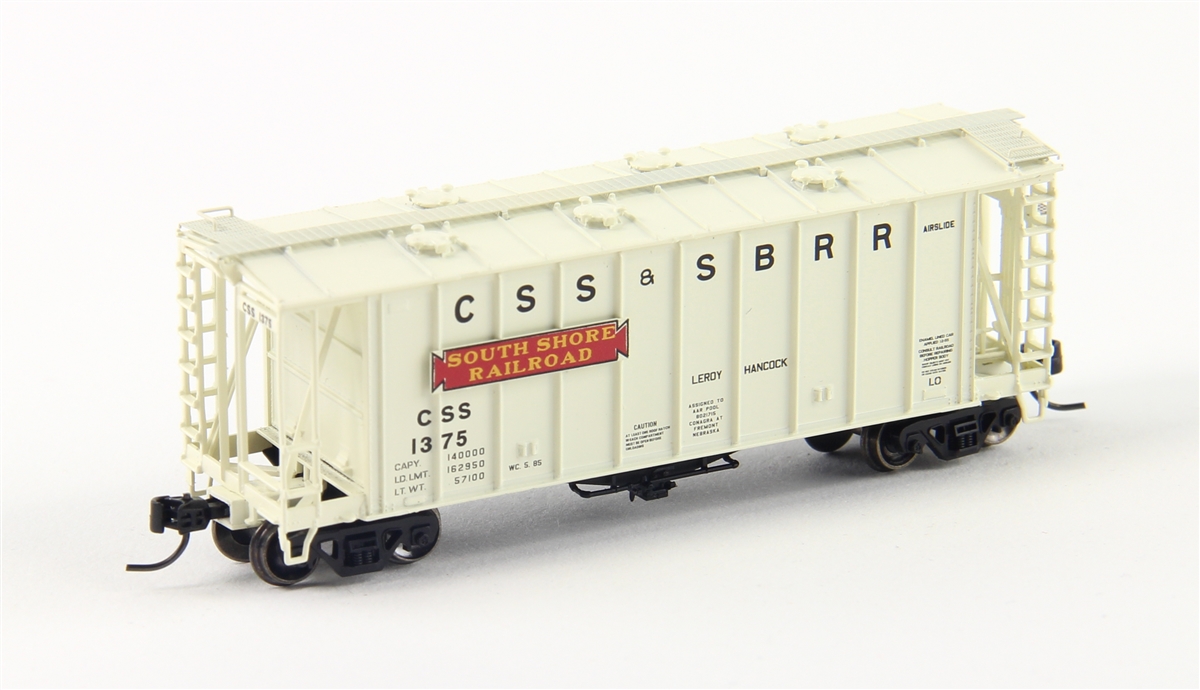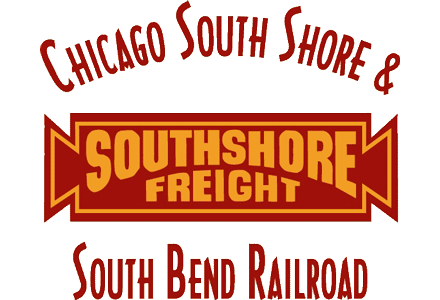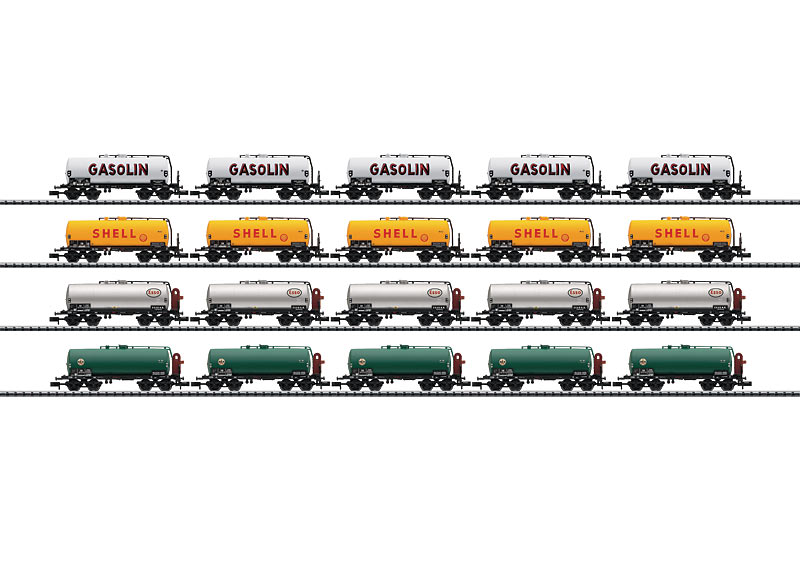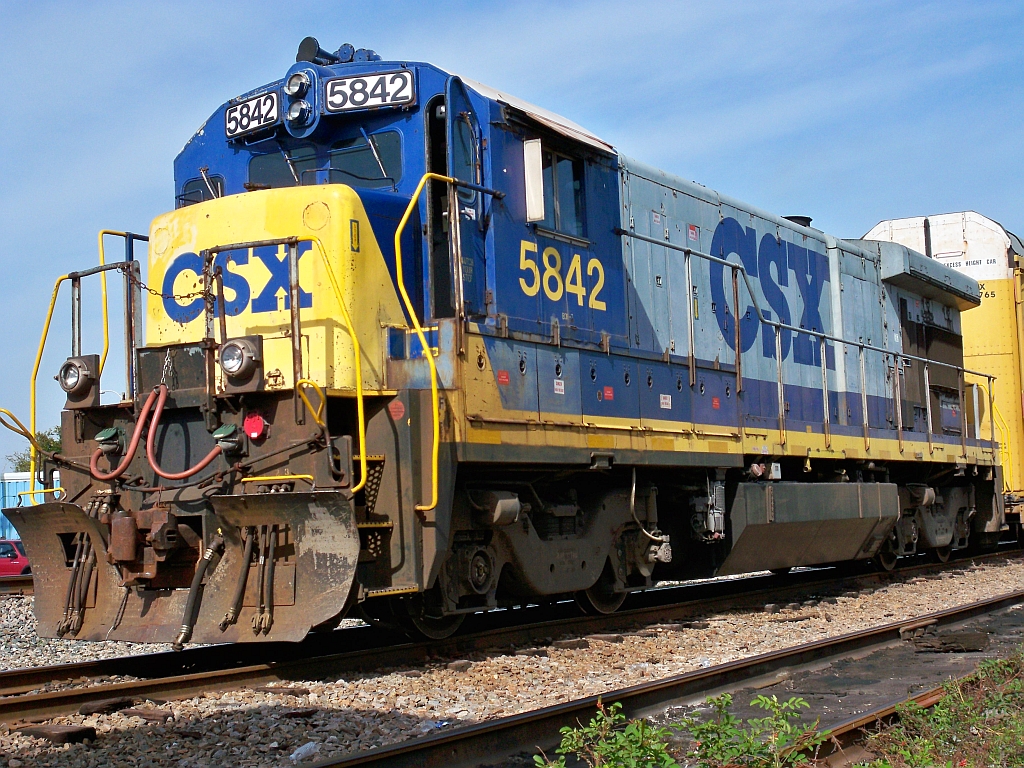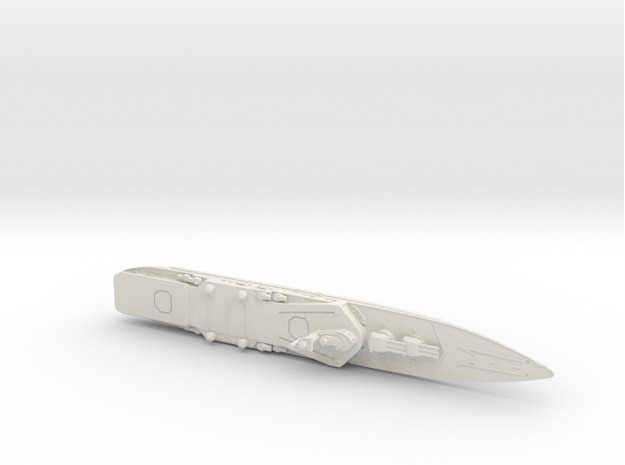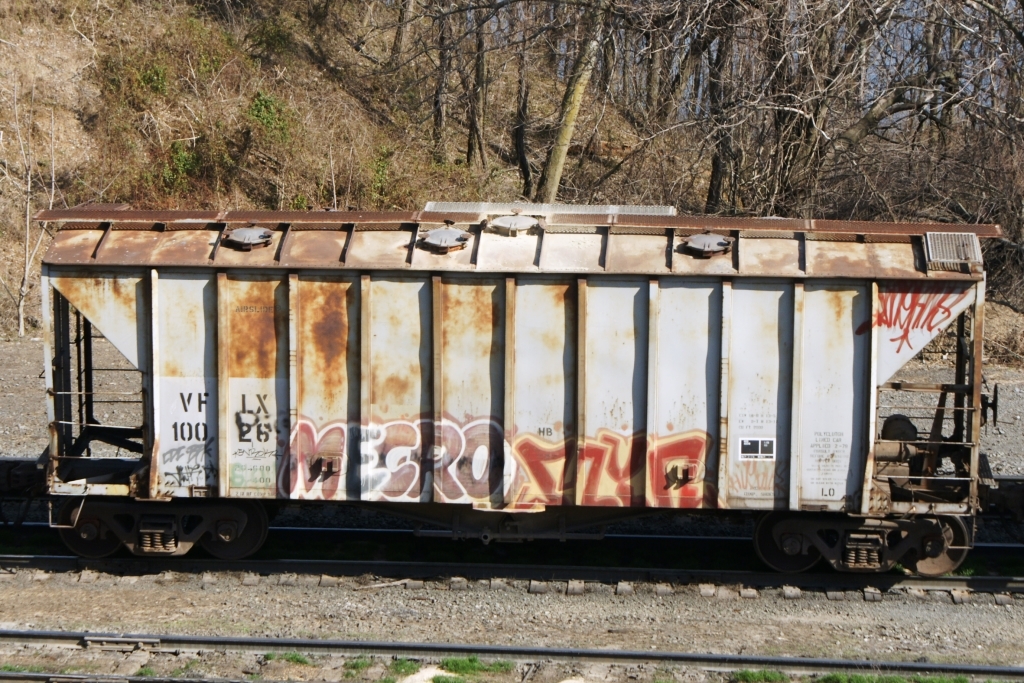Model Information: This is a really impressive model with a surprising array of detail. It is a proper 3rd generation model with body-mount couplers, chemically blackened metal wheels and an array of amazing detail parts. The details include an etched metal roofwalk, hatch covers, and an underframe with at least six different separately applied details. And don't forget the end platform detail - it blows away the Atlas model. Too bad they use McHenry couplers.... I would prefer to see MTL or MTL-knockoff couplers.
This Athearn body style comes in three different variations. (1) Early GATC Airslide body: no angled end gusset plates; channel-section vertical posts at bolsters. (2) Intermediate phase I body: "Hat Section" vertical posts at bolsters; angled gusset plates at ends. All variations feature: Detailed underbody including outlet piping; Rectangular or oval shaker brackets; Gravity or gravity-pneumatic outlets; See through metal roof walk; Factory installed wire grab irons and brake piping; Separately applied round roof hatches and brake wheel; Roller bearing or Bettendorf trucks as appropriate; Accurately painted and printed; Highly detailed, injection molded body; Machined metal wheels; Weighted for trouble free operation; Body mounted McHenry operating scale knuckle couplers; Minimum radius: 9 3/4".
This Athearn body style comes in three different variations. (1) Early GATC Airslide body: no angled end gusset plates; channel-section vertical posts at bolsters. (2) Intermediate phase I body: "Hat Section" vertical posts at bolsters; angled gusset plates at ends. All variations feature: Detailed underbody including outlet piping; Rectangular or oval shaker brackets; Gravity or gravity-pneumatic outlets; See through metal roof walk; Factory installed wire grab irons and brake piping; Separately applied round roof hatches and brake wheel; Roller bearing or Bettendorf trucks as appropriate; Accurately painted and printed; Highly detailed, injection molded body; Machined metal wheels; Weighted for trouble free operation; Body mounted McHenry operating scale knuckle couplers; Minimum radius: 9 3/4".
Prototype History: The airslide covered hopper was introduced by General American Transportation Corporation (GATX) in 1953. Approx. 5000 of the 2600 cu. ft. cars were built between that year and 1969. The airslide is primarily designed for the bulk shipment of dry, granular or powdered commodities. The design of that car is such that it can be loaded and unloaded quickly and with little spillage through the use of air pressure. The most common commodities carried include: flour, sugar, starch, plastic pellets, cement, powdered chemicals and carbon black.
he Airslide was first patented in 1953, the same year Pullman Standard introduced their PS-2. What made the car unique was a set of fabric membranes in the hopper bays. Made of tightly woven cotton and treated with silicone, the Airslide® membranes were moisture-proof but allowed air to pass through. Compressed air was supplied at the unloading site and passed through the membrane up into the load. This aerated the load, allowing it to flow easily through the hoppers.
he Airslide was first patented in 1953, the same year Pullman Standard introduced their PS-2. What made the car unique was a set of fabric membranes in the hopper bays. Made of tightly woven cotton and treated with silicone, the Airslide® membranes were moisture-proof but allowed air to pass through. Compressed air was supplied at the unloading site and passed through the membrane up into the load. This aerated the load, allowing it to flow easily through the hoppers.
Road Name History: The CSS&SB was born in 1925 when traction and utility magnate Samuel Insull acquired and reorganized the Chicago Lake Shore & South Bend. The CLS&S was a robustly built electric interurban line connecting South Bend, Indiana with Michigan City, Gary, East Chicago, Hammond and finally Illinois Central’s suburban line at Kensington, Illinois, just south of Chicago. The line was already blessed with broad curves and slight grades so it was not difficult for Insull to convert the line into a heavy electric in a style that would be familiar to fans of PRR, DL&W or Reading. Insull also secured trackage rights on the IC into Chicago. The overhead wire is a mix of catenary and trolley wire (the latter used on some of the low speed street trackage.)
Like many railroads, CSS&SB fell into bankruptcy in 1932 and Samuel Insull lost control. The Golden Age of Traction was over and the new management began to place more emphasis on freight service.
In addition to some boxcab electrics, the South Shore was one of two American roads to own “Little Joe” electrics. These had been built in the 1950s for the Soviet Union but Cold War tensions killed the deal. They were re-gauged (Russia is 5’ gauge) and sold to South Shore and Milwaukee Road instead. The “Little Joe” name was a reference to Joseph Stalin.
In 1967, Chesapeake & Ohio gained control of the South Shore and the occasional C&O diesel could be found switching the South Shore. In 1981, the Little Joe’s were retired and freight operations were dieselized with yellow and blue (like Chessie without the vermilion) GP38-2’s. Passenger operations remained electrified. Passenger losses were subsidized by the state of Indiana through this period. In 1982, the Northern Indiana Commuter Transportation District paid for a fleet of new passenger cars that replaced the heavy steel cars that first went into service in the Insull era.
In 1989, the South Shore fell into bankruptcy, bringing an end to CSX (formerly C&O) control of the line. Northern Indiana Commuter Transportation District took over operation of the money losing passenger operations. The following year, the Anacostia & Pacific short line group established a new Chicago South Shore & South Bend Railroad to provide freight service on the line. It was this group that brought back the orange and maroon paint scheme last used on the Little Joes. They currently operate 182 miles of line, much of it on trackage rights.
Traffic on the South Shore is primarily a pair of power stations that receive unit coal trains and mills that ship pig iron and finished steel. They also carry grain, manufactured goods, paper, and roofing materials.
Major customers include: Alexander Chemical, ArcelorMittal-Burns Harbor, Criterion Catylst & Technologies, GAF Corporation, Five Star Sheets, Foodliner, Maryland Pig Services, Northern Indiana Public Service, NAMASCO/Primary Steel, PSC Metals, Reserve Marine/Transfer Logistics, Rollcoater, Sims Metal Management, U.S. Steel - Midwest, USALCO, and Windy City Warehouse.
Like many railroads, CSS&SB fell into bankruptcy in 1932 and Samuel Insull lost control. The Golden Age of Traction was over and the new management began to place more emphasis on freight service.
In addition to some boxcab electrics, the South Shore was one of two American roads to own “Little Joe” electrics. These had been built in the 1950s for the Soviet Union but Cold War tensions killed the deal. They were re-gauged (Russia is 5’ gauge) and sold to South Shore and Milwaukee Road instead. The “Little Joe” name was a reference to Joseph Stalin.
In 1967, Chesapeake & Ohio gained control of the South Shore and the occasional C&O diesel could be found switching the South Shore. In 1981, the Little Joe’s were retired and freight operations were dieselized with yellow and blue (like Chessie without the vermilion) GP38-2’s. Passenger operations remained electrified. Passenger losses were subsidized by the state of Indiana through this period. In 1982, the Northern Indiana Commuter Transportation District paid for a fleet of new passenger cars that replaced the heavy steel cars that first went into service in the Insull era.
In 1989, the South Shore fell into bankruptcy, bringing an end to CSX (formerly C&O) control of the line. Northern Indiana Commuter Transportation District took over operation of the money losing passenger operations. The following year, the Anacostia & Pacific short line group established a new Chicago South Shore & South Bend Railroad to provide freight service on the line. It was this group that brought back the orange and maroon paint scheme last used on the Little Joes. They currently operate 182 miles of line, much of it on trackage rights.
Traffic on the South Shore is primarily a pair of power stations that receive unit coal trains and mills that ship pig iron and finished steel. They also carry grain, manufactured goods, paper, and roofing materials.
Major customers include: Alexander Chemical, ArcelorMittal-Burns Harbor, Criterion Catylst & Technologies, GAF Corporation, Five Star Sheets, Foodliner, Maryland Pig Services, Northern Indiana Public Service, NAMASCO/Primary Steel, PSC Metals, Reserve Marine/Transfer Logistics, Rollcoater, Sims Metal Management, U.S. Steel - Midwest, USALCO, and Windy City Warehouse.
Brand/Importer Information: Athearn's history began in 1938, when its founder-to-be, Irvin Athearn, started an elaborate O scale layout in his mother's house. After placing an ad selling the layout, and receiving much response to it, Irv decided that selling model railroads would be a good living. He sold train products out of his mother's house through most of the 1940s. After becoming a full-time retailer in 1946, Irv opened a separate facility in Hawthorne, California in 1948, and that same year he branched into HO scale models for the first time.
Athearn acquired the Globe Models product line and improved upon it, introducing a comprehensive array of locomotive, passenger and freight car models. Improvements included all-wheel drive and electrical contact. One innovation was the "Hi-Fi" drive mechanism, employing small rubber bands to transfer motion from the motor spindle to the axles. Another was the double-ended ring magnet motor, which permitted easy connection to all-wheel-drive assemblies. Athearn was also able to incorporate flywheels into double-ended drives.
The company produced a model of the Boston & Maine P4 class Pacific steam locomotive which incorporated a cast zinc alloy base and thermoplastic resin superstructure. It had a worm drive and all power pickup was through the bipolar trucks that carried the tender. This item was discontinued after the Wilson motor was no longer available, and was not redesigned for a more technologically advanced motor.
Athearn's car fleet included shorter-than-scale interpretations of passenger cars of Southern Pacific and Atchison, Topeka & Santa Fe Railroad prototypes. The company also offered a variety of scale-length freight cars with sprung and equalized trucks. The cars could be obtained in simple kit form, or ready-to-run in windowed display boxes. The comprehensive scope of the product line contributed to the popularity of HO as a model railroad scale, due to the ready availability of items and their low cost.
Irv Athearn died in 1991. New owners took control in 1994, but continued to follow Athearn's commitment to high-quality products at reasonable prices. Athearn was bought in 2004 by Horizon Hobby. Athearn was then moved from its facility in Compton to a new facility in Carson, California. In mid-2009, all remaining US production was moved to China and warehousing moved to parent Horizon Hobby. Sales and product development was relocated to a smaller facility in Long Beach, California.
Read more on Wikipedia and Athearn website.
Athearn acquired the Globe Models product line and improved upon it, introducing a comprehensive array of locomotive, passenger and freight car models. Improvements included all-wheel drive and electrical contact. One innovation was the "Hi-Fi" drive mechanism, employing small rubber bands to transfer motion from the motor spindle to the axles. Another was the double-ended ring magnet motor, which permitted easy connection to all-wheel-drive assemblies. Athearn was also able to incorporate flywheels into double-ended drives.
The company produced a model of the Boston & Maine P4 class Pacific steam locomotive which incorporated a cast zinc alloy base and thermoplastic resin superstructure. It had a worm drive and all power pickup was through the bipolar trucks that carried the tender. This item was discontinued after the Wilson motor was no longer available, and was not redesigned for a more technologically advanced motor.
Athearn's car fleet included shorter-than-scale interpretations of passenger cars of Southern Pacific and Atchison, Topeka & Santa Fe Railroad prototypes. The company also offered a variety of scale-length freight cars with sprung and equalized trucks. The cars could be obtained in simple kit form, or ready-to-run in windowed display boxes. The comprehensive scope of the product line contributed to the popularity of HO as a model railroad scale, due to the ready availability of items and their low cost.
Irv Athearn died in 1991. New owners took control in 1994, but continued to follow Athearn's commitment to high-quality products at reasonable prices. Athearn was bought in 2004 by Horizon Hobby. Athearn was then moved from its facility in Compton to a new facility in Carson, California. In mid-2009, all remaining US production was moved to China and warehousing moved to parent Horizon Hobby. Sales and product development was relocated to a smaller facility in Long Beach, California.
Read more on Wikipedia and Athearn website.
Item created by: gdm on 2016-12-19 07:19:39. Last edited by gdm on 2023-11-26 09:43:28
If you see errors or missing data in this entry, please feel free to log in and edit it. Anyone with a Gmail account can log in instantly.
If you see errors or missing data in this entry, please feel free to log in and edit it. Anyone with a Gmail account can log in instantly.


